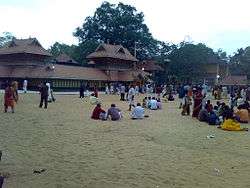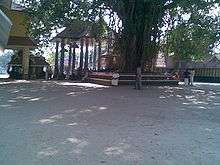Sarkaradevi Temple
| Sarkaradevi Temple | |
|---|---|
 | |
| Name | |
| Proper name | Sarkara Devi Temple |
| Geography | |
| Country | India |
| State | Kerala |
| Location | Chirayinkeezhu, Attingal |
| Culture | |
| Primary deity | Goddess Bhadrakali |
| Architecture | |
| Number of temples | Attachment with Nakramcode Devi Temple,Avanavanchery |
Sarkaradevi Temple is one of the most important temples in South India. It is situated South of the Chirayinkeezhu Taluk (in the North-West of Thiruvananthapuram district). The nearest town is Attingal and Varkala. Tradition accords a remote antiquity to this temple. Its main deity is Bhadrakali. The Sarkaradevi Temple assumed a significant status for many reasons and rose to historical importance mainly with the introduction of the famous Kaliyoot festival by Anizham Thirunal Marthanda Varma, the Travancore sovereign, in 1748.The Sarkaradevi Temple have some basic attachment with Nakramcode Devi Temple which located in Avanavanchery,Attingal.

History
Chirayinkeezhu Taluk being directly under the immediate administration of the Attingal, Kerala Swarupam, the Attingal Ranis where entrusted by the TravancoreRaja with the conduct of the elaborate festival of Kaliyoot. The Attingal Rani being related to the Travancore royal family through adoption from the Kolathunadu royal family. From the time of Venad Kings, had enjoyed independent rights in several respects over the neighbouring regions and temples and at times even over the entire Venad. Even the King Marthanda Varma annexed Attingal to Travancore, soon after ascending the throne Marthanda Varma decided to assume direct control over Attingal 'estate'. The Ranis seem to have been allowed to continue in their independent status in many respects. Hence it was no wonder that when the former decided to introduce Kaliyoot festival in the Sarkaradevi Temple of Chirayinkeezhu Division, he entrusted the responsibility to the Attingal Ranis, even though the finances came directly from the Travancore royal treasury.
Famous Film Actor Prem Nazir donated one elephant to the Sarkara Devi Temple.

The Attingal Ranis in the turn bestowed the members of the military family of Ponnora Panickers (When two princesses were adopted from Kolathunad, some senior members of the Ponnara family are said to have accompanied them as bodyguards to Attingal, where the former were settled by the Venad Kings. The descendents of the family are still residing there, with the responsibility of supervising the grand festival. Even now the responsibility is continuing with the descendents of the Ponnara family. One of the most important peculiarities of this temple is that it is the only temple in South Kerala where such elaborate Kaliyoot festival is conducted. Another festival which makes the temple the center of attraction is the Meenabharani mahotswavam which is conducted for ten days in the month of March–April every year.
Festivals
Kaliyoot
The chief festival in the temple is the festival of kaliyoot, which falls on the Malayalam month of kumbham (March). Kali, the Mother of goddess is the deity of farmers. It is evident from the inclusion of the fictitious interpretations of agricultural art traditions in the rituals of the art form of Kaliyoot. Kaliyoot is the dramatic presentation of the genesis of Bhadrakali and Darika the representatives of good and evil respectively, their confrontation and later the extermination of Darika in devotional terms and with rhythmic footsteps. Kaliyoot is a synthesis of older agrarian art tradition is a further established by the fact that the time chosen for performing Kaliyoot after Makara Koithu (the Malayalam month of Makaram corresponds to March and in the season of the second harvest season in Kerala. Koithu is a Malayalam term for harvest ) and that Kali appears under the guise of a pulaya (the pulaya caste is the traditional agricultural labouring community in Kerala.) girl in the Kali drama.
The object of Kaliyoot festival is to offer the elementary harvest to the Amma (the divine Mother), the defender of the land.The ritual art of Kaliyoot was originally celebrated in North Malabar to propitiate Goddess Kali was brought to Travancore and that too to the Sarkara Temple by King Marthanda Varma (1729–1758). There is a historical legend connected with it.For expanding the domain of this kingdom, Marthanda Varma Maharaja tried to capture kayamkulam province several times.(A.P. Ibrahim Kunju, Rise of Travancore, A study of the Life and Times of Marthanda Varma). All his efforts were in vain and he felt disappointed. But he did not give away his ambition. His one and only motive was the defeat Kayamkulam Raja. With the unyielding desire he was forced to make another arrangement for a war. On his way to Kayamkulam it is said that he chose the big ground near the Sarkara temple to take rest.

Learning the arrival of Maharaja in their mace, that leaders of the place or Karakkar and Kalarigurukkars (The grand teachers of military techniques at the Kalari.) assembled together to have a glimpse of the Maharaja. Hearing the Raja's stories of defeat at Kayamkulam, they suggested that the only way to his triumph was to offer a Kaliyoot to Sarkaradevi. In conformity with their suggestion the Maharaja decided to offer Kaliyoot to Sarkaradevi and finally became successful in the war.
Kaliyoot festival is usually celebrated in the month of February/March.It is a 9 day long festival with rituals and traditional ceremonies conducted in the temple premises.The first 7 days ceremonies are dramatic visualisations of stories leading to the war between Bhadrakali and Darika. The ceremonies takes its peak with the 8th and 9th day ceremonies,"Mudi uzhichil" and "Nilathil poru" respectively.
On the 8th day of ceremonies, Bhadrakali herself goes out in search of Darika, but returns at the end of the day without finding the deamon king.This function is one of the most important ritual associated with the festival as on this day the deity offers blessings to the devotees directly.
The famous "Nilathil poru"(ground fight) takes place at the 9th and last day of ceremonies which visualises the killing of deamon king Darika by Bhadrakali and thus spreading the prevalence of truth over the evil.
The 8th and 9th day functions in the Kali drama festival are a visual treat and the colorful ceremonies takes hours for completion.The men from the ponnara family are assigned with the kali,durga and darika costumes.
It is believed that there is a basic text titled Kaliyoot Mahotmyam (It is said that the text composed by Kannassa Panicker.) authored by Kannasa Panicker ceremonies connected with Kaliyoot as a devotional offering.After the construction of the stage for the chief performance the pernu and the invoking of the spirit of the Goddess into lamps, the chief rites of the first days begin and ends with compromising talk between Bhadrakali and darika is known as "Mudithalam Thullal".[1]
Meenabharani Festival
The Meenabharani festival is the second great annual festival in the temple of Sarkara Devi Temple. This festival often falls on the occasion of the annual special poojaof Attavishesham. During the period of king Dharma Raja and his success or Marthanda Varma orders were given for the elaborate conduct of the festival and the expenses like paddy, incurred for the same were recorded.(Mathilakam Records, churana 937,ola, 1639, 1750–51, Kerala State Archives, Trivandrum) The festival of Meenabharani is celebrated for ten days and it is believed that on the tenth day the benevolent Goddess appears and showers her blessings on the devotees. The Meenabharani festival generally starts with Kodiyettu (flag hoisting), nine days before the asterism of Bharani which is considered as the birth star of Sarkaradevi. It ends on the tenth day with Arat (holy immersion) of the deity in the temple tank. There are very interesting ceremonies connected with this festival. On all days recital of the exploits of the Goddess is staged by special teams of people. On the ninth day an important function is conducted in this temple known as Pallivetta. It is believed that during this function Sarkara devi disappears from the temple and she went for hunting. The Goddess is taken in procession as for hunting with the accompaniment of five caparisoned elephants and firetorches to the Bhagavathy palace. Through this hunting she tried to avoid powers of malice and maintain peace and security in this vicinity. During the earlier period animal sacrifices were conducted along with this performance. However, animal sacrifices were avoided during the later periods. Now this function ends with the return procession of the deity and the cutting of a coconut with a bow and arrow. After that the ceremonial Arat of the deity is conducted.
Prem Nazir given one elephant to the Sarkara Devi Temple.
There are various views and related stories are about Sarkara temple.Lots of peoples are coming here in the festival season. Various lands are bringing various festival shows in Meenabharani days. During that days complete Chirayinkeezhu Thaluk is filled with all devotees. It is a land of God and all are calling Goddess as "Sarakara Ponnammachi"
See also
External links
| Wikimedia Commons has media related to Sarkara Devi Temple. |
References
- ↑ http://www.sarkara.org/festivals.htm About Kaliyoot Festival